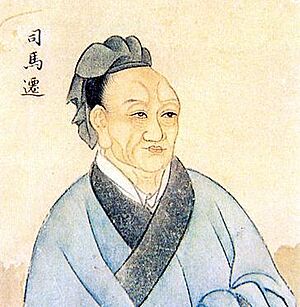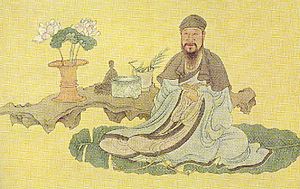Chinese literature facts for kids
Quick facts for kids Chinese literature |
|||||||||||||||||||||||
|---|---|---|---|---|---|---|---|---|---|---|---|---|---|---|---|---|---|---|---|---|---|---|---|
| Traditional Chinese | 中國文學 | ||||||||||||||||||||||
| Simplified Chinese | 中国文学 | ||||||||||||||||||||||
|
|||||||||||||||||||||||
The history of Chinese literature is incredibly long, stretching back thousands of years! It began with official records kept by ancient dynasties and grew into amazing novels that entertained many people during the Ming dynasty.
A big change happened with woodblock printing during the Tang Dynasty (618–907). Later, Bi Sheng (990–1051) invented movable type printing during the Song Dynasty (960–1279). These inventions helped spread stories and knowledge quickly across China. In more recent times, the writer Lu Xun (1881–1936) is seen as the person who started modern Chinese literature, written in everyday language.
Contents
Exploring Chinese Literature: A Journey Through Time
Chinese literature is one of the oldest and richest in the world. It includes everything from ancient poems and philosophical texts to exciting novels and plays. It tells us a lot about China's long history and culture.
Ancient Writings and Wisdom
The very first Chinese writings were often official records or texts about philosophy. These early works helped shape Chinese thought and society.
The First Historians
One of the most famous early writers was Sima Qian. He lived over 2,000 years ago. He wrote a huge history book called Records of the Grand Historian. This book set the standard for how history was written in China for centuries. It's like the first big history textbook!
Deep Thoughts: Philosophy and Poetry
Ancient Chinese literature also includes important philosophical works. Thinkers like Confucius and Laozi wrote down their ideas. These ideas still influence people today. Early poetry often focused on nature, daily life, and feelings.
The Golden Age of Poetry: Tang Dynasty
The Tang Dynasty (618–907 AD) is often called the "Golden Age" of Chinese poetry. During this time, many famous poets wrote beautiful verses.
Famous Tang Poets
Two of the most well-known poets from this era are Li Bai and Du Fu. Li Bai was known for his imaginative and sometimes wild poems. Du Fu wrote about everyday life and the struggles of people. Another important poet was Bai Juyi. He wrote poems that were easy for many people to understand.
Stories for Everyone: Novels and Plays
Later, during the Ming Dynasty (1368–1644) and Qing Dynasty (1644–1912), long stories called novels became very popular. These novels were often written in "vernacular" Chinese. This means they used everyday language, not the formal language of scholars. This made them fun for more people to read.
Classic Chinese Novels
Some of the most famous classic Chinese novels include Romance of the Three Kingdoms, Journey to the West, Water Margin, and Dream of the Red Chamber. These stories are full of adventure, heroes, and deep emotions. They are still read and loved today. Many have been turned into movies and TV shows.
Modern Voices: A New Beginning
In the early 20th century, Chinese literature went through big changes. Writers wanted to use simpler language and talk about modern problems.
Lu Xun: The Father of Modern Literature
Lu Xun (1881–1936) was a key figure in this change. He wrote short stories and essays that criticized old traditions. He encouraged people to think about new ideas. His work helped create modern Chinese literature, which is written in a style called baihua (everyday speech).
Why Chinese Literature Matters
Chinese literature is more than just old books. It's a window into a rich culture and a long history. It helps us understand how people lived, thought, and felt throughout different times in China. It also shows how literature can change and grow over thousands of years.
Images for kids
-
Inside Chongwen Book City, a large bookstore in Wuhan.
See also
 In Spanish: Literatura de China para niños
In Spanish: Literatura de China para niños





